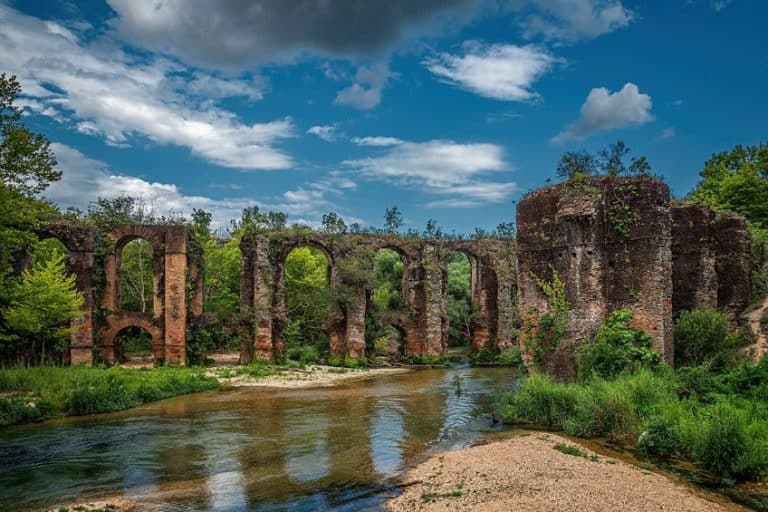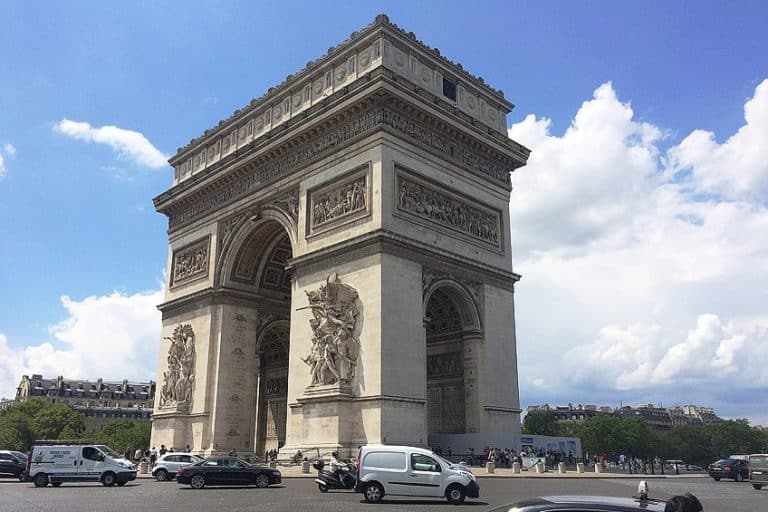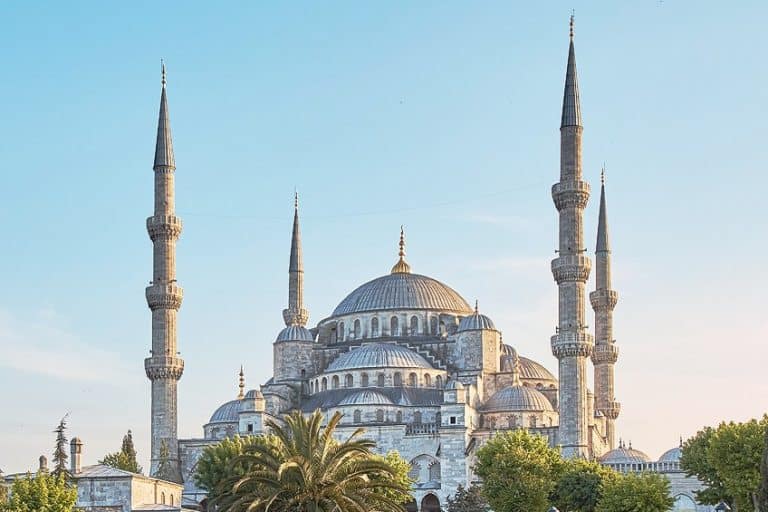Hagia Sophia in Istanbul – The History of the Hagia Sophia Church
Why was the Hagia Sophia built and who built the Hagia Sophia? The Hagia Sophia in Istanbul was initially constructed to function as a Greek Orthodox church. The Hagia Sophia church then served as a mosque after the Ottoman Empire took control of Constantinople. In today’s article, we will examine the history of Hagia Sophia in Istanbul.
The History of the Hagia Sophia Church
| Architect | Isidore of Miletus (c. 473 CE) |
| Date Completed | 537 CE |
| Height (meters) | 55 |
| Function | Church and mosque |
| Location | Fatih, Istanbul, Turkey |
When was the Hagia Sophia built? The current building was erected between 532 and 537 CE to serve as Constantinople’s Christian cathedral by the Byzantine emperor Justinian I and was designed by Isidore of Miletus, the Greek geometer. Once completed, it had the world’s biggest interior area and was one of the first to have a complete pendentive dome. It is regarded as the pinnacle of Byzantine architecture. Where was the Hagia Sophia Built? Constructed in Fatih, Istanbul, the current Justinianic structure was the third building to have occupied the site, as the previous one was demolished during the Nika riots. It was the biggest cathedral in the world for about a thousand years until 1520 when construction was completed on Seville Cathedral.
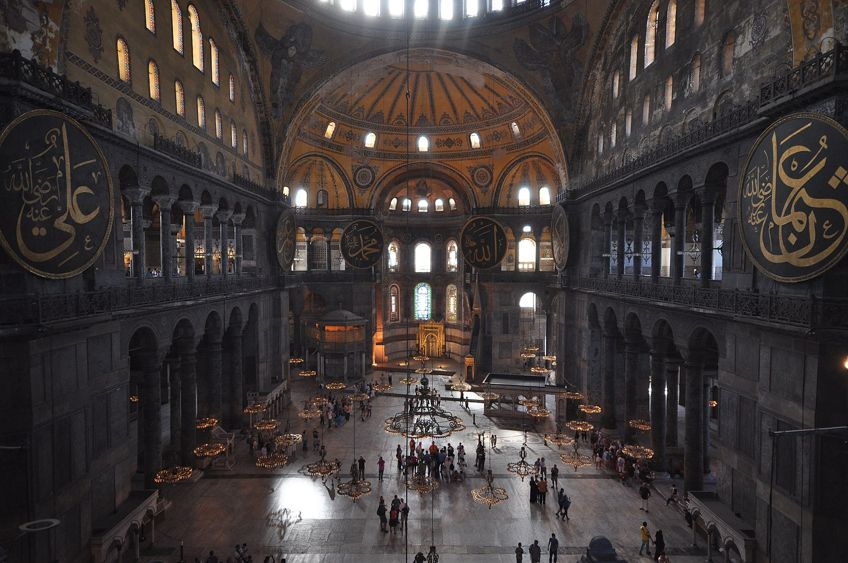 Hagia Sophia “Holy Wisdom” is a former Orthodox patriarchal basilica, later a mosque, and now a museum in Istanbul, Turkey (2012); Jorge Láscar from Australia, CC BY 2.0, via Wikimedia Commons
Hagia Sophia “Holy Wisdom” is a former Orthodox patriarchal basilica, later a mosque, and now a museum in Istanbul, Turkey (2012); Jorge Láscar from Australia, CC BY 2.0, via Wikimedia Commons
The Church of Constantius II: 360 CE
Due to its size in comparison to other churches in the city, the first church built on the site was dubbed the Magna Ecclesia (Great Church). It was constructed near the location where the Great Palace was also being erected. According to Hesychius of Miletus, Constantine constructed Hagia Sophia with a timber roof and removed 427 largely pagan sculptures from the site. The church itself was said to feature a timber roof, columns, curtains, and a west-facing entrance. As with the subsequent churches on the site, the structure was most likely preceded by an atrium.
The upper section of the wall was built with bricks marked with 5th-century brick stamps, while the bottom section is built with 4th-century bricks.
In 1946, a hypogeum, possibly with a martyrium located above it, was discovered, and in 2004, the remains of a brick wall with evidence of marble revetment were unearthed. Based on early literary documentation of the Hagia Sophia church, it was erected on the location of a far older pagan temple. On the 20th of June 404 CE, the Patriarch of Constantinople fell into dispute with Empress Aelia Eudoxia and was exiled. This original church was substantially damaged during the following riots.
The Church of Theodosius II: 415 CE
Theodosius II approved the construction of a second church on the site, which he dedicated on the 10th of October, 415 CE. During the reign of Socrates of Constantinople, around 440 CE, two churches (Sophia and Irene) were surrounded by a single wall and serviced by the same priests. As a result, the entire church complex would have occupied a considerable area, including the eventual location of the Hospital of Samson. The western entrance of the Justinianic Hagia Sophia exposed the western remnants of its Theodosian predecessor, in addition to some Constantinian church elements.
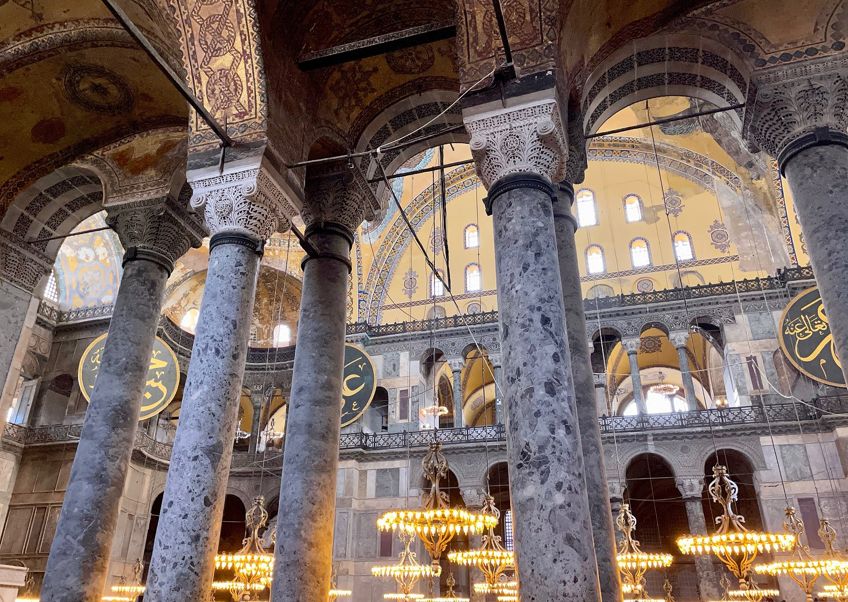 The basket capitals of the building are carved with monograms of the names Justinian and Theodora in the Hagia Sophia (2021); Sonse, CC BY 2.0, via Wikimedia Commons
The basket capitals of the building are carved with monograms of the names Justinian and Theodora in the Hagia Sophia (2021); Sonse, CC BY 2.0, via Wikimedia Commons
The facade was ornately carved with Theodosian-era motifs, portions of which have remained, and the floor just within the portico was adorned with polychrome mosaics. Remnant stone remains of the construction reveal that there was vaulting, particularly at the western end. The skeuophylakion of the 4th century was replaced in the 5th century by the current construction, a rotunda composed of banded masonry on the bottom two floors and plain brick masonry on the third. The second Hagia Sophia was burned to the ground on the 13th of January 532 CE, during the upheaval of the Nika Revolt.
The Church of Justinian: 532 CE
On the 23rd of February, 532 CE, only a few weeks after the demolition of the second church, Emperor Justinian I dedicated a third, entirely new church, bigger and more impressive than its predecessors. Columns and other marble features were transported from all across the Mediterranean, despite the fact that the columns were originally supposed to be spoils from towns like Ephesus and Rome. While they were created exclusively for Hagia Sophia, the sizes of the columns differ. During the building phase, almost ten thousand laborers were employed.
In 726 CE, Emperor Leo issued a number of edicts prohibiting image adoration, commanding the soldiers to demolish all icons, culminating in the era of Byzantine iconoclasm.
All religious images and monuments were taken from the Hagia Sophia during that time. Sultan Mehmed II permitted his men and company three full days of unrestricted pillaging and plundering in the city immediately after it was seized in 1453. During this time, several Orthodox churches were destroyed; the Hagia Sophia itself was plundered since the intruders believed it held the city’s greatest assets. The attackers found their way to the church and broke down its doors before surging inside shortly after the defense of Constantinople’s Walls fell and the triumphant Ottoman army entered the city.
Hagia Sophia Mosque: 1453 – 1935
On the 29th of May, 1453, the Ottoman troops attacked Constantinople. The Sultan entered the city and conducted the Friday prayer at Hagia Sophia, officially converting the structure into a mosque. The priests of the church continued to carry out Christian ceremonies, prayers, and rites until the invaders forced them to cease. When Mehmed entered the church, he immediately commanded that it be turned into a mosque. The church was in a state of decay, with some doors falling off their hinges, and the sultan ordered that it be renovated.
 Hagia Sophia mosque and Ahmed III fountain, Constantinople, Turkey, (ca. 1896); See page for author, Public domain, via Wikimedia Commons
Hagia Sophia mosque and Ahmed III fountain, Constantinople, Turkey, (ca. 1896); See page for author, Public domain, via Wikimedia Commons
Later, during Selim II’s reign, the structure began to show symptoms of wear and was considerably fortified by Ottoman architect Mimar Sinan, who added structural support to the building’s exterior. Sinan added two enormous minarets on the west end of the building in addition to reinforcing the old Byzantine structure. Under Sultan Ahmed III’s reign, the decaying interior plaster was restored in 1717, inadvertently helping to preserve numerous mosaics that would otherwise have been damaged by mosque workmen. In fact, it was common for tourists to purchase the mosaic’s tesserae, which were thought to be talismans.
Renovations of the Hagia Sophia in Istanbul
Sultan Abdulmejid I instructed the 19th-century renovation of the Hagia Sophia, which was carried out between 1847 and 1849 by 800 laborers. The dome was reinforced with an iron chain, the vaults were fortified, the columns were leveled, and the outside and interior of the structure were redesigned. The mosaics in the top gallery were uncovered and restored, but many of them were removed to prevent further damage. Eight additional massive circular-framed medallions were suspended from the ceiling, on every one of the four piers, as well as on each side of the apse.
The architect Fossati constructed a new caliphal loge with an Ottoman-Rococo style marble grille and Neo-Byzantine columns linking to the royal pavilion in 1850.
The minarets outside the main structure were renovated and adjusted to be of equal height. A clock tower was built for the mosque’s timekeeper, and a new Islamic school was established. After it had been restored, The mosque was reopened with a ceremony on the 13th of July, 1849. In 1919, Eleftherios Noufrakis, a Greek Orthodox Christian priest, delivered the very first Divine Liturgy in the Hagia Sophia in Istanbul since the fall of Constantinople in 1453.
Use as a Museum (1935 – 2020)
Mustafa Kemal Atatürk, the first Turkish president, converted the Hagia Sophia church into a museum in 1935. The carpeting and the layers of mortar beneath the floor were removed, and marble designs were visible for the very first time since the renovation when the white plaster that covered many of the mosaics was removed. Hagia Sophia church was Turkey’s second most-visited museum in 2014, with around 3.3 million visitors per year.
 Hagia Sophia Museum (2020); Antoloji, CC BY-SA 4.0, via Wikimedia Commons
Hagia Sophia Museum (2020); Antoloji, CC BY-SA 4.0, via Wikimedia Commons
While the complex’s usage as a place of worship was officially forbidden, the Turkish government approved the designation of a venue in the museum complex to be used as a prayer room in 1991, and two of the minarets have been frequently utilized for voicing the call to prayer since 2013. Several groups and high-level government officials had urged that the Hagia Sophia in Istanbul be turned back into a mosque since the early 2010s. For the very first time in 85 years, Muslim prayers were performed at the Hagia Sophia church on the 1st of July, 2016.
On the 13th of May, 2017, a massive crowd assembled in front of the building and recited a prayer, calling for the museum to be converted back into a mosque.
Reversion Back to a Mosque (2018 – Present)
Since 2018, Turkey’s president has spoken about converting the Hagia Sophia back to a mosque, a decision that appears to be widely supported by the deeply religious public he is hoping to persuade. He said in March 2019 that he would convert Hagia Sophia from a museum back to a mosque, calling it a “very gross mistake” to establish it as a museum. The Council of State overturned the Council of Ministers’ resolution to convert the Hagia Sophia into a museum on the 10th of July 2,020, declaring that the complex cannot be used for any other function than a mosque.
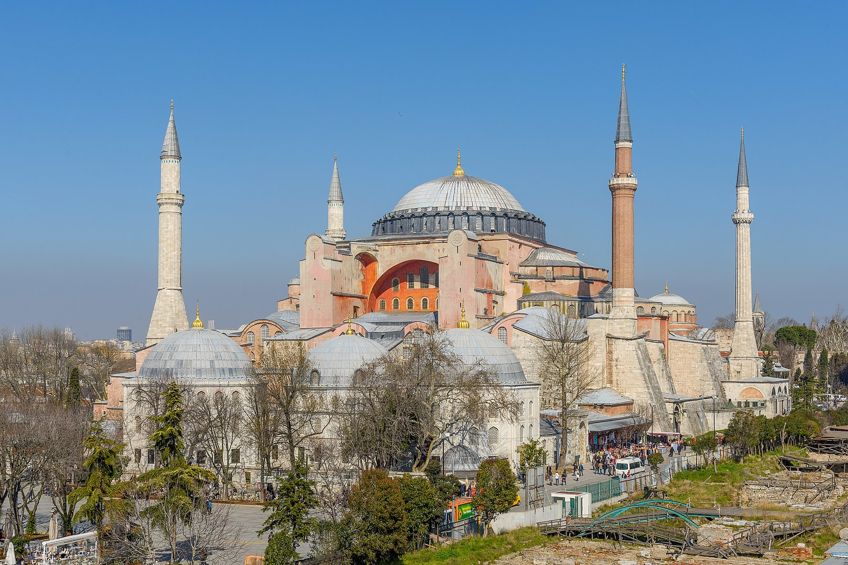 Hagia Sophia (2013); Arild Vågen, CC BY-SA 3.0, via Wikimedia Commons
Hagia Sophia (2013); Arild Vågen, CC BY-SA 3.0, via Wikimedia Commons
Despite secular and international condemnation, the president issued an order removing the Hagia Sophia’s museum designation and converting it to a mosque. Soon after the news of the change, the call to prayer was aired from the minarets and broadcast by various Turkish news organizations. Although the Hagia Sophia in Istanbul has been reborn as a mosque, it is still open to the general public outside of prayer times and admission is free. During this president’s reign, it is the fourth church from the Byzantine era to be changed back to a mosque. The Hagia Sophia had its first Ramadan tarawih prayer in 88 years in April 2022.
The Hagia Sophia church is regarded as one of the best-preserved instances of Byzantine architecture. Its interior is lavishly ornamented with marble pillars, mosaics, and architecturally significant coverings. Justinian oversaw the creation of the grandest church ever built up to that point, and it was to be the largest church for 1,000 years until the cathedral in Seville, Spain, was completed. It has seen many changes and been through many transformations – from church to mosque to museum and back to a mosque again. Despite the latest conversion being decried by Christians and outsiders, it could just be another interesting chapter for the Hagia Sophia in Istanbul, and no one knows what the future may hold.
Frequently Asked Questions
Who Built the Hagia Sophia in Istanbul?
The Hagia Sophia in Istanbul was designed by Isidorus of Miletus, who worked under Emperor Justinian I’s supervision. He was asked to build a beautiful church that would function as the heart of religious life in Constantinople, as well as a monument to the Byzantine Empire’s strength and prestige. Justinian, Emperor of the Roman Empire, ruled the Byzantine Empire as a powerful and prominent emperor, and only the grandest church would suffice.
Where Was the Hagia Sophia Built?
The Hagia Sophia church was constructed in Constantinople, which is known today as Istanbul, Turkey. It wasn’t the first church erected on that site, however. The first building on the site was erected in 360 CE but burned and destroyed in 404 CE after a revolt. It was then reconstructed in 415 CE, only to be burned down during another uprising in 532 CE. The present Hagia Sophia, which still remains today, was erected after 532 CE by Justinian I, the Byzantine Emperor.
Why Was the Hagia Sophia Built in the First Place?
The initial church on the site was erected as a cathedral for Constantinople’s Christian population. The church served as a gathering place for the neighborhood Christian community, as well as a venue for significant religious activities. The church’s function was to be a place of worship, as well as a symbol of the strength and glory of the Byzantine Empire and its religion.
When Was the Hagia Sophia Built As It Appears Today?
The Hagia Sophia as it exists now was constructed in the sixth century, specifically in 537 CE. It has, however, undergone many changes since then. It had also existed before that date as a place of worship as far back as 360 CE.
Justin van Huyssteen is a freelance writer, novelist, and academic originally from Cape Town, South Africa. At present, he has a bachelor’s degree in English and literary theory and an honor’s degree in literary theory. He is currently working towards his master’s degree in literary theory with a focus on animal studies, critical theory, and semiotics within literature. As a novelist and freelancer, he often writes under the pen name L.C. Lupus.
Justin’s preferred literary movements include modern and postmodern literature with literary fiction and genre fiction like sci-fi, post-apocalyptic, and horror being of particular interest. His academia extends to his interest in prose and narratology. He enjoys analyzing a variety of mediums through a literary lens, such as graphic novels, film, and video games.
Justin is working for artincontext.org as an author and content writer since 2022. He is responsible for all blog posts about architecture, literature and poetry.
Learn more about Justin van Huyssteen and the Art in Context Team.
Cite this Article
Justin, van Huyssteen, “Hagia Sophia in Istanbul – The History of the Hagia Sophia Church.” Art in Context. May 12, 2023. URL: https://artincontext.org/hagia-sophia-in-istanbul/
van Huyssteen, J. (2023, 12 May). Hagia Sophia in Istanbul – The History of the Hagia Sophia Church. Art in Context. https://artincontext.org/hagia-sophia-in-istanbul/
van Huyssteen, Justin. “Hagia Sophia in Istanbul – The History of the Hagia Sophia Church.” Art in Context, May 12, 2023. https://artincontext.org/hagia-sophia-in-istanbul/.



